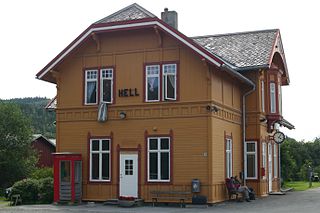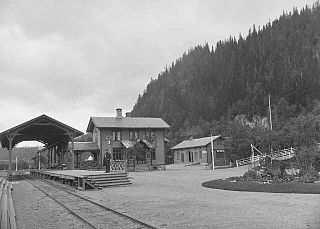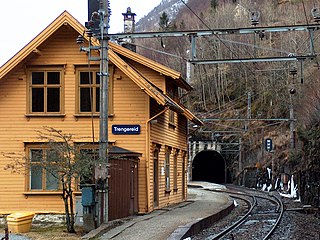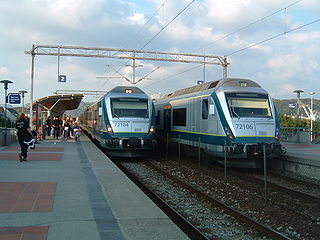
is a municipality in the county of Vestland, Norway. It is located in the traditional district of Nordhordland. The administrative centre is the village of Dalekvam. Other villages in Vaksdal include Dalegarden, Flatkvål, Helle, Nesheim, Stamneshella, Stanghelle, and Vaksdal.

The Jæren Line was a 74.7-kilometer (46.4 mi) long railway line between Stavanger and Egersund in Jæren, Norway. The name is no longer in official use and the section is regarded as the westernmost part of the Sørlandet Line. Owned by Bane NOR, the line has double track from Stavanger Station to Sandnes Station, and single track from Sandnes to Egersund Station. The line is electrified at 15 kV 16.7 Hz AC and equipped with centralized traffic control and GSM-R. The line is served by the Jæren Commuter Rail and intercity trains along the Sørlandet Line, both operated by Go-Ahead Norge. CargoNet runs container freight trains on the line, which terminate at Ganddal Freight Terminal.

The Bergen Line, or the Bergen Railway, is a 371-kilometre (231 mi) long scenic standard gauge railway line between Bergen and Hønefoss, Norway. The name is often applied to the entire route from Bergen to Oslo, including the Randsfjord and Drammen lines between Hønefoss and Oslo, covering a total distance of 496 kilometres (308 mi). It is the highest mainline railway line in Northern Europe, crossing the Hardangervidda plateau at 1,237 metres (4,058 ft) above sea level.

The Rauma Line is a 114.2 kilometres (71.0 mi) long railway between the town of Åndalsnes, and the village of Dombås, in Norway. Running down the Romsdalen valley, the line opened between 1921 and 1924 as a branch of the Dovre Line, which connects to the cities of Oslo and Trondheim. Originally intended as the first stage to connect Ålesund, and possibly also Molde and Kristiansund, no extensions have ever been realized. The unelectrified line is served four times daily with SJ Norge's Class 93, although in the summer the service only operates from Åndalsnes to Bjorli as a tourist service. CargoLink operates a daily freight train.

Hell Station is a railway station located in the village of Hell in the Municipality of Stjørdal in the Trøndelag county, Norway. It is located at the intersection of the Nordland Line and the Meråker Line.

is a village or small town in Dovre Municipality in northern Innlandet county, Norway. The village serves as the commercial centre for the upper Gudbrandsdalen valley. It lies at an important junction of roads with the European route E6 highway heading north and south connecting the cities of Oslo and Trondheim and the European route E136 highway heading west to Åndalsnes. The Dovrebanen and Raumabanen railway lines meet in the village at Dombås Station as well. Dombås Church is located in the village.

The Nordland Line is a 729-kilometer (453 mi) railway line between Trondheim and Bodø, Norway. It is the longest in Norway and lacks electrification. The route runs through the counties of Trøndelag and Nordland, carrying a combination of commuter, long-haul passenger and freight trains. From Trondheim Central Station to Steinkjer Station the line is most heavily used, with hourly services by the Trøndelag Commuter Rail. There are three branch lines—the Stavne–Leangen Line at Leangen Station, the Meråker Line at Hell Station and the Namsos Line at Grong Station.

Forskningsparken is a rapid transit station on the Sognsvann Line of the Oslo Metro. It also serves as a light rail station for the Ullevål Hageby Line of the Oslo Tramway. It is located at the north of the Blindern campus of the University of Oslo in the Nordre Aker borough of Oslo, Norway. The decision to build the station was made in 1998, and it opened in 1999, replacing the former station Vestgrensa, and allowed interchange between the metro and the tramway. The Ullevål Hageby Line was at the same time extended to serve the new Rikshospitalet. Forskningsparken is served by lines 4 and 5 of the metro, each operating every 15 minutes and providing services along both the Sognsvann Line and the Ring Line. Lines 17 and 18 of the tramway serve Forskningsparken, operating to Rikshospitalet and the city center.

The Trunk Line is a railway line in Norway which runs between Oslo and Eidsvoll. The line is owned by Bane NOR.

The Trondhjem–Støren Line was Trøndelag's first railway. It opened on 5 August 1864, ten years after the Trunk Line between Oslo and Eidsvoll opened. The 49 kilometer long railway line was narrow gauged and went between Trondheim and the Støren village in Midtre Gauldal municipality in the county of Sør-Trøndelag, Norway.

The Asker Line is a 9.5-kilometre (5.9 mi) railway line between Asker and Lysaker in Norway. The line runs along the same corridor as the Drammen Line, offering increased capacity, speed and regularity on the rail network west of Oslo. The first part opened in 2005, and in 2011 an extension opened from Sandvika to Lysaker. Original plans called for an extension to Skøyen, but from 2020, new planning is under way for an extension all the way to Oslo Central Station. Most of the railway is in tunnel and is dimensioned for 160 km/h (99 mph) running. The entire railway is electrified at 15 kV 16.7 Hz AC. The first section cost 3.7 billion kr, while the second is budgeted at NOK 2.7 billion.

The Stavne–Leangen Line is a 5.8-kilometer (3.6 mi) railway line between Stavne and Leangen in Trondheim, Norway. The line provides an alternative connection between the Dovre Line and Nordland Line, allowing trains to bypass Trondheim Central Station. The line includes the Stavne Bridge over the river of Nidelva, Lerkendal Station and the 2.7-kilometer (1.7 mi) long Tyholt Tunnel. Construction of the line started during the Second World War by the Wehrmacht, the German military occupying Norway, in an attempt to make the railway in Trondheim resistant to sabotage. Because of the long construction time of the tunnel, tracks were laid in the city streets, but neither route was completed before the end of the war. Construction was placed on hold and the Stavne–Leangen Line did not open until 2 June 1957. At first it was primarily used by freight trains. Since 1988, passenger services from the Dovre Line to Lerkendal Station have been provided, but they do not use the Tyholt Tunnel, instead taking a U-turn back across the Nidelva onto the Dovre Line.

The Trøndelag Commuter Rail is a commuter train service operating in Trøndelag county, Norway. It was operated with Class 92 diesel multiple units by Vy, until 7 June 2020, when SJ Norge took over the contract until 2030. The service provides a commuter service connecting Trondheim to its suburbs, between towns in Innherred and as an airport rail link for Trondheim Airport, Værnes. Although passenger services have operated along the lines since 1864, the commuter train was created with an increase of service with existing rolling stock in 1993. In 2019, the system was used by 1.4 million passengers.
Jernbaneverket was a government agency responsible for owning, maintaining, operating and developing the Norwegian railway network, including the track, stations, classification yards, traffic management and timetables. Safety oversight was the duty of the Norwegian Railway Inspectorate, while numerous operating companies run trains on the lines; the largest being the state owned passenger company Vy and the freight company CargoNet.

Trengereid is a local stop on the Bergen Line. It is located far east in Bergen, Norway, in the Arna borough on the shore of the fjord Sørfjord. The station is between Takvam and Bogegrend stations, at an elevation of 15.7 metres (52 ft) above sea level.

The Ålgård Line is a closed, but not abandoned, railway line between Ganddal and Ålgård in Rogaland, Norway. The 12.24-kilometer (7.61 mi) line was built as a narrow gauge branch line of the Jæren Line by the Norwegian State Railways (NSB) and opened in 1924. It runs through the villages of Foss-Eikeland and Figgjo in Sandnes to Ålgård in Gjesdal. Several proposals were made for the Ålgård Line to become the first part of the main line from Stavanger to Oslo, but instead the Sørlandet Line was connected to the Jæren Line in 1944. At the same time, the Ålgård Line was upgraded to standard gauge.

Lier Station is located at the village of Lier, Norway on the railway Drammen Line. The station is served by the Oslo Commuter Rail L13, service with half-hour headway by Vy. The station is served by line L1, with one departure at 01:54 to Drammen.

Skoppum Station is a railway station on the Vestfold Line in the village of Skoppum, in Horten, Norway. Situated 99.54 kilometers (61.85 mi) from Oslo Central Station, it serves an hourly regional service operated by Vy. The station has two platforms and is itself located on an island platform, giving Skoppum a keilbahnhof design. The station building was designed by Balthazar Lange in Swiss chalet style.

Vestgrensa was a light rail station on the Sognsvann Line of the Oslo Metro in Norway. It opened on 10 October 1934, and was located between Blindern and Ullevål stadion stations. The station was rebuilt when the Sognsvann Line was upgraded from light rail to metro standard in the early 1990s. It was closed on 22 August 1999, when it was replaced by the new station Forskningsparken.

The Jæren Commuter Rail is a commuter train service operated along the westernmost part of the Sørland Line in Jæren, Norway. It is operated by Go-Ahead Norge with nine Class 72 electric multiple units. The service acts as a commuter rail connecting Stavanger to its suburbs, including Sandnes, and to towns further south, in Klepp, Time, Hå and Eigersund. Although passenger services have operated along the lines since 1878, the commuter train service was inaugurated in 1992 with a significant increase of service, using existing rolling stock. Ridership of the system increased from 3.2 million in 2012 to 5 million in 2019.



















